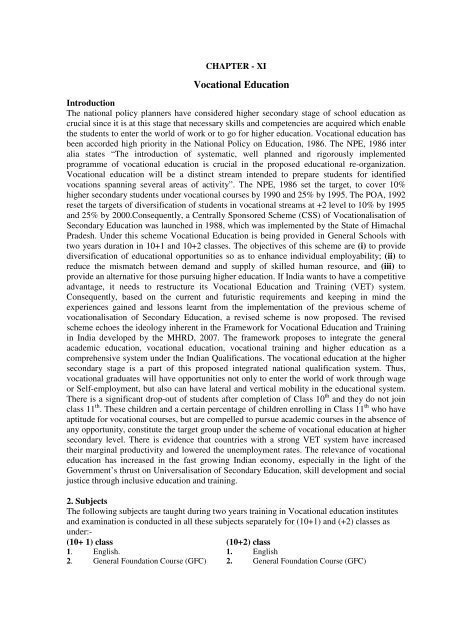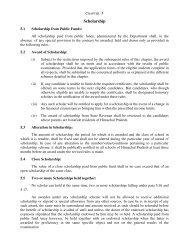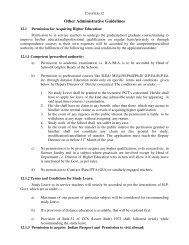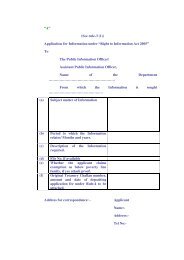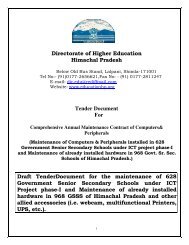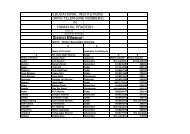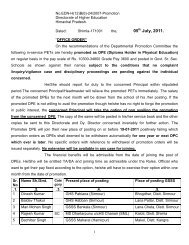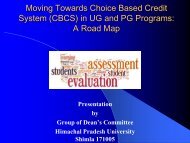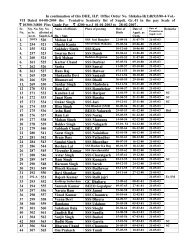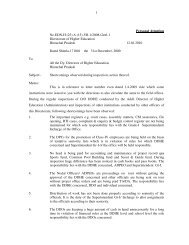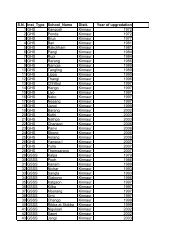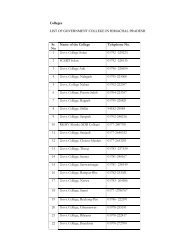Vocational Education - Department of Higher Education
Vocational Education - Department of Higher Education
Vocational Education - Department of Higher Education
You also want an ePaper? Increase the reach of your titles
YUMPU automatically turns print PDFs into web optimized ePapers that Google loves.
CHAPTER - XI<strong>Vocational</strong> <strong>Education</strong>IntroductionThe national policy planners have considered higher secondary stage <strong>of</strong> school education ascrucial since it is at this stage that necessary skills and competencies are acquired which enablethe students to enter the world <strong>of</strong> work or to go for higher education. <strong>Vocational</strong> education hasbeen accorded high priority in the National Policy on <strong>Education</strong>, 1986. The NPE, 1986 interalia states “The introduction <strong>of</strong> systematic, well planned and rigorously implementedprogramme <strong>of</strong> vocational education is crucial in the proposed educational re-organization.<strong>Vocational</strong> education will be a distinct stream intended to prepare students for identifiedvocations spanning several areas <strong>of</strong> activity”. The NPE, 1986 set the target, to cover 10%higher secondary students under vocational courses by 1990 and 25% by 1995. The POA, 1992reset the targets <strong>of</strong> diversification <strong>of</strong> students in vocational streams at +2 level to 10% by 1995and 25% by 2000.Consequently, a Centrally Sponsored Scheme (CSS) <strong>of</strong> <strong>Vocational</strong>isation <strong>of</strong>Secondary <strong>Education</strong> was launched in 1988, which was implemented by the State <strong>of</strong> HimachalPradesh. Under this scheme <strong>Vocational</strong> <strong>Education</strong> is being provided in General Schools withtwo years duration in 10+1 and 10+2 classes. The objectives <strong>of</strong> this scheme are (i) to providediversification <strong>of</strong> educational opportunities so as to enhance individual employability; (ii) toreduce the mismatch between demand and supply <strong>of</strong> skilled human resource, and (iii) toprovide an alternative for those pursuing higher education. If India wants to have a competitiveadvantage, it needs to restructure its <strong>Vocational</strong> <strong>Education</strong> and Training (VET) system.Consequently, based on the current and futuristic requirements and keeping in mind theexperiences gained and lessons learnt from the implementation <strong>of</strong> the previous scheme <strong>of</strong>vocationalisation <strong>of</strong> Secondary <strong>Education</strong>, a revised scheme is now proposed. The revisedscheme echoes the ideology inherent in the Framework for <strong>Vocational</strong> <strong>Education</strong> and Trainingin India developed by the MHRD, 2007. The framework proposes to integrate the generalacademic education, vocational education, vocational training and higher education as acomprehensive system under the Indian Qualifications. The vocational education at the highersecondary stage is a part <strong>of</strong> this proposed integrated national qualification system. Thus,vocational graduates will have opportunities not only to enter the world <strong>of</strong> work through wageor Self-employment, but also can have lateral and vertical mobility in the educational system.There is a significant drop-out <strong>of</strong> students after completion <strong>of</strong> Class 10 th and they do not joinclass 11 th . These children and a certain percentage <strong>of</strong> children enrolling in Class 11 th who haveaptitude for vocational courses, but are compelled to pursue academic courses in the absence <strong>of</strong>any opportunity, constitute the target group under the scheme <strong>of</strong> vocational education at highersecondary level. There is evidence that countries with a strong VET system have increasedtheir marginal productivity and lowered the unemployment rates. The relevance <strong>of</strong> vocationaleducation has increased in the fast growing Indian economy, especially in the light <strong>of</strong> theGovernment’s thrust on Universalisation <strong>of</strong> Secondary <strong>Education</strong>, skill development and socialjustice through inclusive education and training.2. SubjectsThe following subjects are taught during two years training in <strong>Vocational</strong> education institutesand examination is conducted in all these subjects separately for (10+1) and (+2) classes asunder:-(10+ 1) class (10+2) class1. English. 1. English2. General Foundation Course (GFC) 2. General Foundation Course (GFC)
3. <strong>Vocational</strong> Theory -1 3. <strong>Vocational</strong> Theory -IV4. <strong>Vocational</strong> Theory -11 4. <strong>Vocational</strong> Theory -V5. <strong>Vocational</strong> Theory -111 5. <strong>Vocational</strong> Theory -VI<strong>Vocational</strong> Practical -1<strong>Vocational</strong> Practical -IV<strong>Vocational</strong> Practical-11<strong>Vocational</strong> Practical-V<strong>Vocational</strong> Practical-III<strong>Vocational</strong> Practical-VIThe syllabus and question papers <strong>of</strong> English for plus one and two are the same as that <strong>of</strong>academic side <strong>of</strong> 10+1 and 10+2 classes.3. Tuition FeeEvery boy student is charged tuition fee at par with science students and no fee is charged fromgirl students.4. Working HoursWorking hours <strong>of</strong> each <strong>Vocational</strong> <strong>Education</strong> Institute is as per Govt. Norms (i.e. six hoursevery day). Second Saturday <strong>of</strong> every month and every Sunday are closed days <strong>of</strong> the institute5. AttendanceEvery student has to complete minimum 75% attendance in every year <strong>of</strong> two year courses forappearing in the annual examinations in both theory as well as practical.6 .Examination and CertificationExamination <strong>of</strong> plus two students <strong>of</strong> <strong>Vocational</strong> <strong>Education</strong> is also conducted by H.P. Board <strong>of</strong>School <strong>Education</strong> Dharamshala and successful candidates are awarded certificates like otherstudents.7. Eligibility for AdmissionAny 10 th pass student <strong>of</strong> any recognized board is eligible for admission in 10+1 vocationalcourses. There will be no percentage bar to seek admission to <strong>Vocational</strong> Courses. The girlstudents can seek admission in Boys schools where vocational courses are running. Theconcerned Principals and lecturers will make all sincere efforts to motivate the students foradmission in vocational courses.8. EnrolmentThe enrolment <strong>of</strong> students in vocational courses should be as per the norms prescribed byMHRD Govt. <strong>of</strong> India. Efforts will be made to promote enhancement <strong>of</strong> enrolment <strong>of</strong> girls,SC/ST/OBC, minorities, BPL, children with special needs, etcNo. <strong>of</strong> vocational courses: 2 per schoolNo. <strong>of</strong> students per vocational course: 50 (25 in each Class i.e. XI and XII).No. <strong>of</strong> vocational students in each school: 100No. <strong>of</strong> Sections in each School: 49. Equipment and Raw MaterialThe adequate requirement in terms <strong>of</strong> tools, equipment and machinery for the development <strong>of</strong>s<strong>of</strong>t and basic technical skills would be provided to the schools. The list <strong>of</strong> the tools and
There will be a placement cell in each school so that the follow-up data <strong>of</strong> the pass out studentscan be maintained. Sincere efforts will be made at Directorate level to set up linkage withindustries so that campus interviews may be conducted to provide employment. Monitoring willbe done at Directorate level. The <strong>Vocational</strong> lecturers <strong>of</strong> all subjects will ensure the participation<strong>of</strong> students in Job fairs/ Rojgar-Melas conducted by various companies from time to time. Theywill maintain record/register <strong>of</strong> pass out students who go for higher studies/ selfemployment/wage employment or any other filed. They will remain in close contact with variousprivate companies, chamber <strong>of</strong> commerce and employment exchange. However the state levelcoordination will be done by <strong>Vocational</strong> branch <strong>of</strong> Directorate <strong>of</strong> <strong>Higher</strong> <strong>Education</strong> Shimla.17. Apprenticeship TrainingTraining has been consistently felt that students <strong>of</strong> the vocational courses at +2 level should beprovided facilities for apprenticeship training under the Apprenticeship Act as an importantcatalyst for promoting vocational education. In 1986, the Apprentices Act was amended toprovide training to vocational students <strong>of</strong> +2 level (Technician <strong>Vocational</strong> Apprentices). Atpresent there are 94 vocational courses covered under the Apprentices. Efforts would be madeto cover all vocational students under the Apprentices Act. The State coordination Cell for VEshould liaise with the BOATS for apprenticeship training <strong>of</strong> the students. . The Principals willsend the names <strong>of</strong> students for apprenticeship to the Directorate well in time so thatconsolidated data be sent to APPRENTICE BOARD KANPUR (UP) for apprentice training <strong>of</strong> thestudents.18. Vertical MobilityIt is generally experienced that the student community and society at large, in spite <strong>of</strong> a valideconomic and educational rationale for it, find <strong>Vocational</strong> <strong>Education</strong> unacceptable owing toits” terminality “and demand vertical mobility into higher level courses leading to diploma/degree. Any <strong>Vocational</strong> programme which does not allow learner to go for a related course <strong>of</strong>higher studies will be perceived as a dead end. It will have the effect <strong>of</strong> restraining thedevelopment <strong>of</strong> individual in their working level, which in turn will greed frustration. In view<strong>of</strong> the above, it is required to find out ways and means for linking <strong>Vocational</strong> <strong>Education</strong> at theplus two level with higher education to provide right employability to <strong>Vocational</strong> pass outs.Various strategies, Modalities and action Plans were made for linking <strong>Vocational</strong> <strong>Education</strong> atplus two levels with higher education. In the entire planning <strong>of</strong> upward mobility to the field <strong>of</strong>higher education care should be taken that this linking should be complementary andsupplementary to his /her basic knowledge and the resources used during /<strong>Vocational</strong><strong>Education</strong> should not go down the drain. In Himachal Pradesh some seats are reserved in eachpolytechnic for <strong>Vocational</strong> Pass out students who secure 60% or more than 60% marks throughlateral admission. They get admission in 2 nd year <strong>of</strong> diploma in their respective area.19. PublicityExtensive publicity applying various possible modalities such as local set up as well as massmedia (newspapers, magazines, newsletters, radio, television, internet, etc.) should be done forcreating the right image <strong>of</strong> the vocational courses and to attract the youth towards thevocational education. Specific publicity and orientation campaigns need to be designed atsuitable levels.20. Role <strong>of</strong> School Management CommitteeEvery School Management Committee (SMC) will work for smooth functioning and qualityassurance <strong>of</strong> the vocational schools and courses, functioning within nationally set / approvedstandards and guidelines. The committee will advise the school in selection <strong>of</strong> courses,
teachers/trainers, guest faculty, equipment etc. It will facilitate setting up <strong>of</strong> PTC, studentsupport systems and help the school in forging linkages with the industry and studentplacement for practical and on job training and employment. In case <strong>of</strong> need, SMC can set upvocational advisory committee to improve implementation and quality.21. Monitoring/Inspection <strong>of</strong> <strong>Vocational</strong> <strong>Education</strong>The Principals <strong>of</strong> <strong>Vocational</strong> Schools will monitor the various activities <strong>of</strong> vocational<strong>Education</strong> in respective Schools. They will apply different methods <strong>of</strong> vocational guidance,motivation and awareness among students, guardians and society about vocational <strong>Education</strong>.They will ensure that the enrolment <strong>of</strong> students should not be less than 25 in each class/sectioni.e. in each school there will be minimum 100 students in vocational <strong>Education</strong> in +1 and +2classes. The Head <strong>of</strong> Institute will ensure that 100% practicals are performed by the vocationalstudents as per syllabus. For this purpose Raw materials, Instructional material and equipmentswill be arranged well in advance in starting <strong>of</strong> new session. The Principals will ensure at theend <strong>of</strong> the session the physical verification <strong>of</strong> the <strong>Vocational</strong> workshops and stocks every year.The Principal will also manage field visit / industrial visit and on the job training facility forvocational students every year preferably during vacation period. The Deputy Director <strong>of</strong>concerned Districts will specially inspect/ check the various activities vocational <strong>Education</strong>during inspections and report the matter to the higher authorities.


